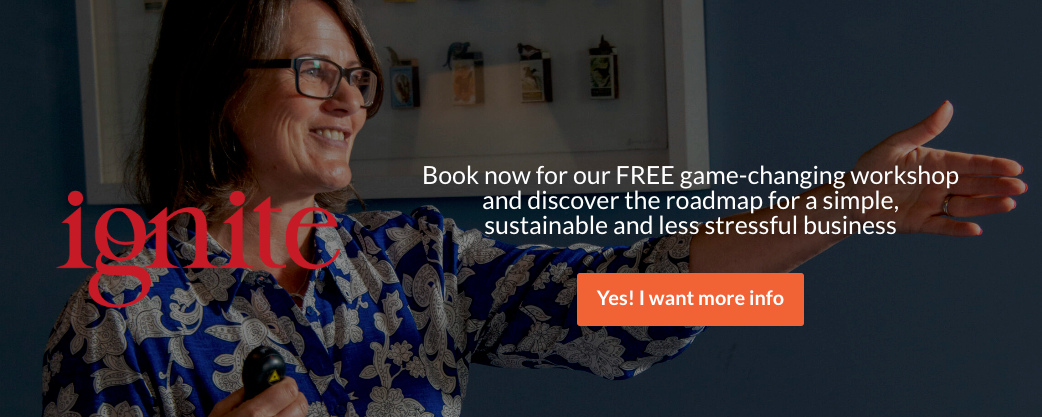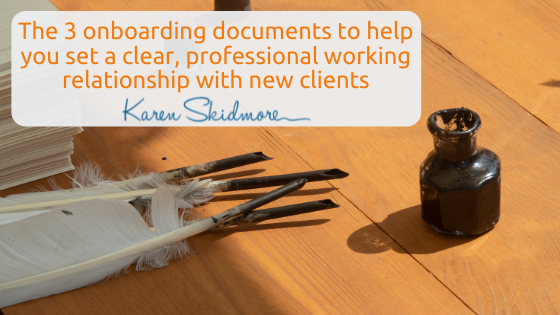
by Karen Skidmore | 02,24 | Business Planning, Business Process, True Profit
Have you ever stopped to think why you run your business the way you do?
Most people have ended up with their current model based on one of two reasons;
- It’s because it’s what everyone else in your profession is doing
- You’ve followed advice to teach you what is the most profitable or easiest to run
Running your business like everyone else
First, you may have the same business model as everyone else in your profession, not because of choice but because you don’t know any better. There’s no judgment here; what you don’t know, you don’t know. You may have spent a lot of time learning about marketing and getting clients, but you’ve probably never given much thought to how to design, set up and run your business.
Doing what everyone else in your profession does has its upsides because you know what works already. Why reinvent the wheel? However, there is a big problem with this. Just because most of your colleagues or competitors run their business in a particular way doesn’t necessarily mean they are all doing it correctly.
But … 80% of your profession are doing it wrong
If we take the Pareto Principle, which statistically proves that 80% of output comes from 20% of input, then we could theorise that 80% of the success in your profession comes from just 20% of businesses in that profession.
If we flip this the other way, 80% of businesses in your profession create just 20% of the output.
Hmmm …
Let’s stop and think about this and wonder how true this is.
Could we conclude that no matter which profession or business sector you operate in, too many people seem to be struggling? Look around at the faces at your next networking event or industry conference; how many of those businesses would you say are flourishing?
The reality is that many are experiencing one or more of the following:
- Overwhelm; procrastination over marketing initiatives and new product ideas because busy-ness is taking over the day-to-day, and there’s no space to work creatively on projects that will grow the business
- Overworked; stuck in the never-ending to-do-lists and client delivery
- Underpaid: competing on price and charging by the hour or the time spent with clients, which often leads to over-delivery and doing far more than initially promised to try and keep clients happy
This paints a pretty depressing picture, especially if you realise you may be in this average 80%!
What about the top 20% of your profession?
Are they creating 80% of the output?
There will be, of course, all sorts of reasons for the success of these top 20%, and yes, there is every chance that they are using technology to create massive growth advantage opportunities to allow them to stand out as leading experts in your profession.
You’ve probably already seen colleagues and competitors create new ways of sharing their expertise. From expanding their offerings to serving groups of clients, large and small, through to creating digital content and cutting-edge use of AI, the opportunities to do something ‘different’ and grow the number of clients you work with are open to you if that’s what you want.
This leads me to the second instance, where many of you may choose your business model based on what’s been taught to you as the most profitable or easiest to run.
Running your business because you’ve been taught this is the way that will make you the most money
The internet became mainstream in the late 1990s, changing our lives. When I started my first business in 2004, email marketing and blogging began emerging for small businesses. When the doors opened to mainstream social media sites, such as Facebook and Twitter, digital growth skyrocketed and advances in technology today, don’t seem to be showing any signs of slowing down.
Unsurprisingly, the explosion in selling digital content since 2015 has led to tens of thousands marketing experts teaching digital ways of making money and growing a business from your laptop on the beach, particularly within the consulting and coaching professions.
Because technology has been the reason for the success of a lot of businesses which are very visible online, it’s easy to get sucked into believing that digital is the only way to grow a business.
But this is simply not the case.
Many marketplaces are now flooded with digital offerings that it’s hard to break in and claim your space, especially when so much of the content can be of poor quality. Your client base may already begun to distrust this form of learning or support. I am sure you have already experienced digital learning and Zoom fatigue over the past few years.
You also have to consider that plenty of businesses in this top 20% bracket are running different or more traditional business models. You may not even realise they exist because you don’t get to see their marketing campaigns or brand presence on your Facebook or Instagram feed.
I remember a client told me once that she was impressed by the number of people I would attract at my live training events despite her needing to see more marketing about it. She wasn’t seeing it because I wasn’t targeting her; she was already my client. So be aware that there is plenty of success around you that you are not even aware of; because it’s not being marketed to you, you don’t see it.
Let’s get honest about how it is to run a top 20% business.
On paper, you may have a business that is well within your profession’s top 20%, especially if you are measuring its success on key performance indicators such as turnover, market share or social media followers. But, if you are a regular reader of my blogs and articles, the reality of trying to run a business in the top 20%, measured in this way, is that it may be burning you out.
If you feel you may be getting burnt out by trying to run a business in the top 20%, you will probably be experiencing one or more of the following:
- You’re overwhelmed; you’ve stepped up and created your expert status but don’t like the visibility and constant pressure to perform.
- You’re overworked; you can’t keep up with what you’ve promised your clients and can’t come up for air long enough to hire the right people to help you grow.
- You’re underpaid; your turnover may be great, but there’s not much left for you once you’ve paid your team, advertising invoices and running costs.
Again, another depressing picture, perhaps.
But you won’t be the only one to have created a business that is burning you out because this practice of growing a business based on following someone else’s formulas and business model is rife.
This is why I want you to see the possibilities available by a business model that allows your business to give you the time, money and energy you want and not have it running you into the ground.
You have a choice.
It may be that you are still looking for a formula to follow because you don’t know which direction you should be going in. And creating a formula for your success is what I want to help you with, but based on a choice that gives you the freedom to grow.
You have a choice on what business infrastructure, processes and team to have in place to give you the right business to help you achieve your creativity, purpose and money aspirations to be your authentic self, do good in the world and make money in the process.
You can choose the design, setup and how you run your business based on how you want success to look for you, just the way you can decide on the right car to drive every day.

Choosing which car to drive is similar to choosing what kind of business to run
There are so many different types of cars on the road because each of us has another reason for choosing our mode of transport and to varying stages of our lives.
Starting out, you’ll probably drive any car you can afford, a small hatchback, or even stick to your bike, especially if you live in a city. Families may drive a big SUV. Some may like fast cars. Others choose their mode of transport based on environmental impact and may even decide they don’t want to own a vehicle and instead use Uber or rental cars for longer journeys.
No one car is right for everyone.
And so it is with your business model.
You can decide on several different business models, but that’s not to say you have to pick just one.
You’ll likely decide you want a hybrid, like many electric cars are entering the market. But a word of caution here: be careful of mixing in too many as you may be in danger of creating a convertible SUV that runs on pedal power; no matter how innovative that may be, you’ve got very little chance of getting it off your driveway!
There’s every chance your business model will also change and evolve as you go on your business journey, just as a couple may swap their compact convertible for an SUV when they begin their family, or a city dweller who relies on their bike may realise they need a car when they move out to the suburbs.
As you and your business grow, you may develop new skills or be attracted to new marketplaces and audiences. You will also stretch your thinking over the years and imagine more significant and different opportunities as you grow confident and shift many limiting beliefs.
So, it’s essential to know that your choice of business model becomes part of your longer-term thinking. You may even need to swap your small hatchback for that super fast sports car quicker than you thought if your business takes off!
If you would like to know more and want help with how you shape the way you run your business, then I invite you to join me on my next live Ignite Workshop. It’s a great place to learn more about how business can work FOR you rather than have a business that works you into the ground.
Click here to see the next dates and book your place.
Meanwhile, I hope this has helped you step back from doing what 80% of your profession does or try to work hard to follow the latest marketing formulas and digital trends.
Has this opened your eyes to realising that you can grow a business to suit you and how you work best?
Until next time,



by Karen Skidmore | 08,22 | Business Process, Winning Business
It’s not nice, but it happens! No matter how good your selection process is for winning clients, you will find yourself working with someone who you don’t want to work with anymore.
They may not be paying their invoices on time, or they are consistently late to meetings. Or will even on occasion not even show up and not think to message you.
Perhaps they are the ones holding up the project you’ve agreed to work on; you can’t move forward with what you’ve promised to deliver because they or one of their team members haven’t given you what you needed, and it’s mucked up your delivery schedule with your other clients.
And then there are the clients that you’ve been working with for a while, but because of the shifts you are making into new offerings and pricing structure, and you’re spending too much time and energy on the kind of clients you don’t want to work with any more.
Having to fire a client certainly isn’t a sign of success, but recognising that you have a problem with a client is certainly a sign that you are shifting your business and your CEO thinking forwards. And if you don’t do anything about it now, it is going to become an even bigger problem over the coming months.
So how do you go about firing a client? Especially when you’ve probably worked hard to get them and frankly, you could do with the money and maybe not be in a position to refund anyone who may have paid upfront. I get it; it’s not a nice job to have to do.
Over the past 18 years of running my own coaching and training businesses, I’ve fortunately not had to fire many clients. But I remember in the early days how painful it was, and how wrapped up emotionally I was in the whole process. I feel awful letting people down and I simply hate conflict. But over the years, I’ve learnt how to deal with it so that both me and my client come out happy, because when I didn’t deal with it at the time, I let the situation get far trickier than it needed to be.
Here’s my suggestions on how to deal with clients you want to fire.
1. Identify that you have a problem. Say it out loud to yourself and acknowledge that this is a problem you have to sort out. This is an important first step because too often, especially if you are busy, it’s easier to ignore all the signs and you begin to justify the situation and make allowances for your client’s behaviour. As soon as you begin to allow your client to have this power over you, it’s amazing how servient you can become ie doffing the proverbial cap, with a yes sir, no ma’am. When your professional boundaries start to slide like this, it can become very toxic, very quickly, and will have an impact on you are working with your other clients.
2. Review the situation. Before you start ranting and raving about your terrible client, take a step back and review what really may be going on. Have you addressed the fact that your client hasn’t paid on time/been late for meeting/not done their ‘homework’? And what boundaries did you have in place at the start of the working relationship, and how clear did you make these to your client? If you haven’t got clear terms and conditions, contract or service level agreements signed, then you have to take responsibility for not setting the working relationship boundaries clear in the first place. Get this sorted asap so you don’t fall foul of this ever again! If you have, then you have perfect grounds to set a meeting with your client (and I recommend that you do this outside of any agreed paid-for consulting/coaching time), to discuss how certain boundaries have slipped, and how you can both get back on track.
3. Assume the best, always. In my experience, the few clients who I have had to fire over the years were never bad people. Yes, they had bad behaviour but when we discussed what was going on, it was usually as a result of something in their personal life, such as a health crisis or stress levels, or they were struggling with cash flow. Is your client finding it hard to keep with the agreed timeframe because of other work commitments? Have they got a problem at home that is taking their attention? Has their boss given them a different directive that is now clashing with the project you are working on together?
4. Communication is key; and always best done in person. When in doubt, always pick up the phone or arrange a meeting. Don’t try to resolve a problem with a tricky client via email because typed words can be taken in so many ways. And definitely don’t use emojis to try to do this work for you, yes?! So yes, you may not like conflict as I very much don’t, but you can’t hide behind an email because you won’t get to the root of the problem.
5. Maybe you don’t need to fire the client. Which takes me to this important step in the process. When you get to the root of the problem, you may find that addressing this actually deepens your working relationship, and if you can both come to a solution, may ensure you have a brilliant client for life. Of course, have your bull shit radar on 😉 but if you remember step 3, most people aren’t out to screw you over!
6. Keep your decision quick and commercial. If you do decide the best thing is to break your contract (which of course will depend on what is in your contract – see step 2 above!), then stay away from any emotional reasons, and make the decision quickly. Remember there are always two sides to every situation and you don’t want to be caught up in a justification argument ie he said/she said. State the facts, always confirm everything in an email, keep it clean, and refer back to your original contract/service level agreement that was set at the start of the relationship.
7. Do you need to offer a refund if they’ve paid upfront? Again, this decision needs to be taken commercially, not emotionally. If your contract states that no refund is needed, whether you or them cancel the contract, you may still want to review this and give them something (see my next point). I’ve always taken the ‘what’s fair for both of us?’ approach and have even asked the client this question on occasion. You don’t need to justify, but you can lay down exactly what they have received, especially if your project/programme is top heavy and most of the value was at the front end. Sometimes the cleanest thing to do to break the relationship is to give something back, so you can both move on (see my next and final point).
8. Finally, make it a win for your client, too. You don’t need to go above and beyond trying to find a replacement, for example, but they have to feel they have come out of this situation well, too. If they feel hard done by, or are made to feel a bit like a prat or incompetent (especially if you’ve called out their bad behaviour such as being late for meetings), you again run the risk of being caught up in a justification argument, or even worse, have them shame you publicly on social media, which can obviously get very messy. In my experience, the bad behaviour they have demonstrated with you, is often the same bad behaviour they have with other suppliers and team members, so expecting the client to be remorseful or apologise is not something that’s going to happen. Let them win, too and you’ll find it easier to move on and get working with the clients you do love to work with.
One of the big things I teach my clients is how to stay in Power Partnership; the ability to recognise that neither you nor your client are better than each other. Yes, you may well be the expert that they are paying for, but you are both equal powers in the working relationship.
Feeling more powerful than your client, and you will come across as arrogant. Feeling less powerful than your client and you will come across as a people pleaser, doffing that proverbial cap with your yes sir, no ma’am tone.
So if you are reviewing your clients right now and realising that you may have one or two clients you need to fire, step back and ask yourself first where are you in your Power Partnership? Because you can fire a client today, but if you don’t realign your power state, you could be letting in another tricky client as fast you’ve got rid of the last one.
If you want help in putting the right systems and processes in place so that you avoid attracting clients that you have to end up firing, then let’s talk. Book a call with one of our Grow Strong business coaches. There’s never any charge for our first call together. Click here to check out times available.

by Karen Skidmore | 06,21 | Business Process, Product Strategy
I’m writing about boundaries this month; those often invisible lines that we need to have to protect and fuel our time and energy. Last week I wrote about the 4 work boundaries to increasing profitability and avoiding burnout. This week, I want to shine the light on how clear your legal and professional working relationship needs are set with your clients.
When so much attention is given to sales and marketing, the legal processes and terms of engagement of a new client starting to work with you are often overlooked. For some of you, it’s a lack of awareness. After all, what you don’t know, you don’t know. For others, it can feel dull, confusing or perhaps a little scary.
And I’m here to tell you that none of that needs to happen.
There’s no shame in not knowing what you aren’t even aware of. And if you have been shying away from this area of your business (or even burying your head in the sand!), then I want you to know that it is far easier and simpler than you may be making it out to be.
In this week’s article, I have broken down the three documents to use during your onboarding process with new clients that set up your Power Partnership working relationship. With these in place, you will find a real shift in your business, no matter what it is that you actually do with them or for them.
First of all, what is a Power Partnership™?
Partnership Power™ is the phrase that I use to teach my clients how to sell and work with clients from a place of equal power.
When you let your work and personal boundaries slip, you start to give up your power and this can lead to some clients beginning to take liberties with you. Sometimes this shows up as simply not turning up to meetings on time or not giving you what you need in order to do your work, such as completed questionnaires. With others, they may start asking for discounts or add-ons to what you’ve already agreed.
When you start saying ‘no problem’ to them, you allow your power to shift away from you even more and the relationship has the danger of quickly becoming toxic; behaviour such as unpaid invoices going unpaid to start or cancelling meetings without notice.
But take too much power over your clients, dictate your terms and not show any flexibility or compassion when needed, you will come across as arrogant, cold or dismissive of their needs. This, of course, would start pushing away clients and your business will suffer.
Setting clear working relationship boundaries doesn’t mean you need to become Queen Bitch. Putting the right legal and terms of engagement in place is about creating the space and container for both and your client to work side by side, in partnership and in service with each other, rather than you becoming the servant.
Let’s dive into the three things that will give you this container.
1) Terms of Service
Whatever you sell, your clients have to be aware of the parameters of your professional working relationship; basically, getting clear on what it is that they’ve actually bought.
If you don’t set the rules at the start, your client won’t know when they are stepping over the mark or requesting something that you can’t or don’t want to deliver on. Remember you are in service to them, rather than taking on a servant role.
The specifics of your working relationship need to include:
- Exact outline of your service and/or programme. If you’ve done this via a proposal, then this should be pretty clear. But if you’ve sold via a conversation or click on your website, then having a welcome pack or email to confirm what it is that your client is receiving from you, is critical. You may have told them on the phone the details or have it listed on your website, but your clients are human; they won’t have heard or read every detail so it’s important that you clarify this at the start of your working relationship to ensure their expectations are met and they is no ambiguity on what was on offer.
- Cancellation policy. In the UK, anything sold that your client hasn’t seen in person (which is anything you sell, unless you have an in-person gallery or shop that you are selling from), gives them the right to a 14 day cooling off period. But what happens if they no-show or they want to cancel a contract or workshop? How do you deal with emergency situations when they genuinely can’t keep their agreed time? Is there a charge in place when they don’t? If you are in any doubt that you need to have clear cancellation or postponement clauses in your terms, then I always recommend you take inspiration from your dentist; you’d never be able to cancel an appointment at the last minute without a financial penalty. Why should you be any different?
- Confidentiality. Is this important to highlight in your client work? Do they need reassurance of the level of confidentiality and how you will manage this?
- Payment terms. When do you expect payment and how? It’s not good enough to let your clients pay you when it suits them. You either set up a pay-before-we-start-work-together process or invoice with 5 days payment terms, slightly longer perhaps if you are dealing with a finance team in an organisation, but certainly not 90 days which I’ve seen one of my own clients feel obligated to agree to.
These terms of service don’t need to be long and legal. You can create a very personable welcome pack or letter that highlights the promise you are making to your client and the level of service you are giving them, without lots of small print.
For those of you who work directly as a coach, consultant, trainer or therapist, I do recommend you get your clients to sign one, rather than just email them a copy for reference, before you start working together because it means they’ve read it and acknowledged how your relationship is going to work. There are some good, inexpensive options such as Hellosign that make this signing process work easily online.
2) Terms and conditions
Technically, there’s very little difference between a Terms of Service and a Terms and Conditions. Many businesses will refer their clients to one document and contract.
But I like to split them apart because I find that many of you reading my articles run businesses that involve personal relationships with your clients. Simply having a long, legal contract as your only form of service or programme confirmation, can be rather daunting for your client. They may even be scared off or feel it’s all rather too serious if this is their first time working with someone like you. On the other end of the scale, only having a Terms of Service welcome pack can mean you miss out on some important legal points that protect both you and your clients.
So for clarity, I am referring to your Terms of Service as a read-friendly document that confirms your client working relationship; a welcome pack or letter or proposal. Your Terms and Conditions is a statement of both you and your clients’ legal rights. This is the document that is needed to protect you both in case of a breakdown of your working relationship, unforeseen circumstances that mean you may not be able to deliver what you’ve sold and cover things such as IP, professional indemnity and data protection.
Now I am sure you would never want or even imagine a breakdown of a working relationship. But the truth is that it happens. And when it does happen, it usually happens at the worst possible time. So it is critical that you have clear and legal terms and conditions set up for your business and have them both listed on your website, and have them sent to your clients at the start of the working relationship.
If you are a UK Business and want some well written templates to work from, then I can highly recommend The Small Business Legal Academy which is where I’ve got all my contracts and terms of service documents from.
https://smallbusinesslegalacademy.co.uk/sbla/
(Please note: the above link is an affiliate link and if you make a purchase, I will receive a small commission. I recommend this service because it’s something that I have already purchased, use in my own business and wholeheartedly recommend.)
3) Fair Play Agreement
This third document may be overkill for some of you, but for those of you who are about to embark on a long term working relationship or consultancy project, then a Fair Play Agreement document can be a really useful addition to your onboarding process.
I have to give credit to one of my clients for this name; Jon Norton from http://www.barefootaccounting.co.uk/ came up with this name to use in his accountancy practice and I love it. You, of course, can come up with your own name and version.
What this document gives your client is a clear outline of what you both agree to do for each other to enable a successful outcome. It is particularly useful for professional services, consultants or design companies who have used a proposal to confirm the exact nature of the project or contract, and then want to highlight some key working practices during the onboarding process.
This may include some of the following:
- Support times and access to you. How do your clients reach you whilst working with you? If you don’t want them calling you on your mobile number, why do you have it on your business card or email signature? What response time do you promise for emails or phone messages?
- Information from the client. What ‘homework’ or information do you expect your client to give you by when? If you are working to tight deadlines or managing a design project for them, and you can only deliver based on what your client gives, being clear on what you need and when, will help prevent project creep or any blame that you are at fault. Rather than have to become Queen Bitch and quote any legal obligations, you can use this agreement to keep in your Power Partnership.
- Expectations of how people are treated. You may have an assistant or a number of associates that will work with your client, so it may be that you want to ensure the right level of trust and respect is given to your team members.
Although not a legal document, it is something that I would recommend asking your client to sign, as above with your Terms of Service.
Having all three of these documents in place not only protect you and your client, but create a strong set of working relationship boundaries. Each time I help our clients put these in place in their business, there is a visible difference to the way they work within weeks.
Yes, they can take some thinking out. But do the work and you have a clear and professional onboarding process that sets the tone for a sustainable and profitable working relationship.
And as a final note, these aren’t just to be used with your new clients. If you need to get some (or all!) of your clients realigned with your new working relationship boundaries, then communicating these with them will only show you in better professional light. They set the tone for working together sustainably in the future, and can always be a great reason for bringing some more painful clients to the end 😉
Let me know what you end up putting in place and what impact these documents have on your business.
Until next time, do less, be more, play bigger.


by Karen Skidmore | 01,19 | Business Process, Product Strategy
When a client spends money with you, do you deliver what you promise?
Of course, you do!
But if you are like 80% of business owners who sell their expertise and talent, you probably deliver far more than what was expected of you.
Over delivery is a common problem and not only does it mean you work harder than you need to and puts you on the path to burnout, but it also affects your profitability and your ability to grow your business.
Let me show you how.
Example #1 Corporate trainer & executive coach working in the tech industry
The last few years have been good. Business has turned up when they needed it (but only just in time, to be honest!). But at the end of last year, they felt exhausted. She’d been to 15 different cities and 4 different countries to deliver her training and executive coaching and she felt out of control over who needed the follow-up reports she promised.
Here’s what she’s letting happen:
- She is saying yes to every project that comes her way because she’s not sure when her good luck is going to run out. Consequently, she’s blocked out her diary to the max some months, running back-to-back with different clients.
- Her one day that she promised herself to keep free for a day at home, without work is now being spent at her laptop typing up reports and support documents that she agreed to do because she wants to impress her clients and get the repeat business they promised, even though these weren’t included in the original proposal.
- Her coaching clients are turning up late for their 121 sessions and recently she’s been left waiting patiently on the conference call whilst one client took another call and had to answer an urgent email.
Example #2 Therapist with a busy clinic
She’s got a busy schedule and from the outside looking in, she appears to have a successful and thriving clinic. But over the past few months, she’s getting tired and looking at her bank account again this week, she’s wondering why she never seems to have enough cash to do the things she wants to grow her clinic, such as that online booking system she knows will help grow her client base.
Here’s what she’s letting happen:
- Client sessions are overrunning because she’s giving them a longer treatment than advertised, which means clients who are turning up on time are being kept waiting.
- Clients are cancelling on the day which means she has spare chunks of clinic time she can’t resell at such short notice.
- Clients aren’t re-booking their next appointment before they leave because she’s telling them it’s OK to do it later in the week. They never do.
Even if you’re not this corporate trainer or therapist, do you recognise similar problems in your business?
The real truth behind all of these problems is that clients are not giving you these problems; you are allowing them to happen. You’ve let your professional boundaries slip by giving your clients everything they ask for, and more at times.
Something I teach my clients is Partnership Power; the ability to sell and work with clients from a place of equal power. When you let your boundaries slip, you start to give up your power and the power shifts over to your client. This can lead to them starting to take more liberties, perhaps start asking for discounts or add-ons to what you’ve already agreed. And when you start saying yes to these, you let your power shift away from you even more and the relationship can fast become toxic, with invoices even going unpaid.
But take too much power over your clients, and you can come across as arrogant, cold or dismissive of their needs. This, of course, would start pushing away clients and your business will suffer.
So setting boundaries doesn’t mean you need to become Queen Bitch. Far from it. Setting boundaries are about creating the space and container for both and your client to work side by side, in partnership and in service with each other, rather than you becoming the servant.
Before we dive into the practicals of how to take back control and put in strong boundaries, first let’s look at why you may be allowing these problems to happen.
Over the past 15 years of working with clients, I see these same reasons come up time and time again.
1) Feeling of a lack of worth; you don’t really believe how good you are at what you do and subconsciously overcompensate in make sure your clients are happy with their results. This often messes with your head when it comes to selling because you tie up the “no” to buying from you to mean that you aren’t good enough, rather than the offer you are making.
2) Need to be recognised; tied in with a low level of self-worth, you only feel you’re doing OK when other people tell you so. So because you want more people saying “yes” to buying from you, you charge far lower prices than you should be charging.
3) People pleasing; you are programmed to make sure all your clients are happy and pleased at all times. On one hand, it is important to strive to a high level of customer happiness but the reality is that, in business, you just aren’t going to meet every one of your clients’ expectations, all of the time. Some people simply don’t like or see the value in what it is you offer … and that’s OK.
I have had challenges with all three of these over the years. So it’s OK if you recognise one or more of these. We are all human, after all. And, in my experience, they never completely go away but live in my head like a piece of software waiting to start up at times when I’m feeling down or business is not going so well. So although it is important to spend time unravelling the emotional thinking behind your over-delivering, what I want to share with you here are some practical ways of putting in strong professional boundaries.
Once you start setting the right rules, structure and systems for you and your clients to work towards, you’ll find you will get fewer opportunities to allow your people pleasing or the need to be recognised to rear their ugly heads. And you need to re-balance the Partnership Power in your client relationship so you are working together, rather showing up as the servant.
1.Set Your Working Hours
To begin with, you may make your calendar available to anyone who is interested in speaking with you. But as your diary starts to fill up with appointments, it’s easy to lose control and become highly unproductive. It’s time to set your working hours.
Believe it not, you have total control of your working week. You may not feel it right now, but you can decide exactly when you work and where. That’s the beauty of being your own boss, yes?
For example, Monday morning is sacred to me; it’s for my weekly reflections and planning, my weekly cash flow and money, my weekly team meeting with my assistant. The time I allow my clients to book into my diary is from Monday afternoon through to Thursday, afternoons only. I also don’t work past 5 pm.
What specific working hours do you want to set? You may like to work evenings but don’t start work until 11 am. Perhaps you only want 3 days a week, term times only. Set your working hours, block out your diary accordingly and don’t let your clients or client work take you away from this.
2) Contracts, Terms of Service & Signed Agreements
Whatever you sell, your clients have to be aware of the parameters of your professional working relationship. If you don’t set the rules at the start, your client won’t know when they are stepping over the mark or requesting something that you can’t or don’t want to deliver on. Remember you are in service to them, not serving them.
The specifics of your working relationship need to include:
- Cancellation policy – What happens if they no-show or cancel late? How do you deal with emergency situations when they genuinely can’t keep their agreed time? Is there a charge in place when they don’t? (Any dentist does this now, so why should you be any different?)
- Confidentiality – Is this important to highlight in your client work?
- Support times and access to you – How do your clients reach you whilst working with you? If you don’t want them calling you on your mobile number, why do you have it on your business card or email signature? What response time do you promise for emails or phone messages? (ie instant is not an option unless they are VIP level and they paying good money for this kind of response!)
- Payment terms – When do you expect payment and how? It’s not good enough to let your clients pay you when it suits them. You either set up a pay-before-we-work process or invoice with 5 days payment terms, slightly longer perhaps if you are dealing with a finance team in an organisation (but certainly not 60 days which I’ve seen some my own clients feel obligated to agree to).
These documents don’t need to be long and legal. You can create a very personable contract or terms of service that highlights the promise you are making to your client and the level of service you are giving them, without lots of small print. But I do recommend you get your clients to sign one, rather than just email them a copy for reference, before you start working together because it means they’ve read it and acknowledged how your relationship is going work.
If you want some well-written templates to work from, then I can highly recommend The Small Business Legal Academy which is where I’ve got all my contracts and terms of service documents from.
https://smallbusinesslegalacademy.co.uk/sbla/
3) Don’t Discount; Negotiate
Sometimes you are going to get clients who want to work with you but either don’t have the money or don’t want to commit themselves to the full offering straight off. It’s easy when you may be feeling unsure of yourself and lack the number of sales you may need that month to start bartering and discounting. But you lose your Partnership Power and you are starting your client relationship off on the wrong foot.
In my experience, the client that bartered and got a discount ended up a toxic client; they rarely did their “homework” between our sessions and they often didn’t pay my invoices on time.
So rather than discount, negotiate what’s on offer. If they can’t or don’t want to pay the price you are quoting and you’ve decided that you would like to work with this client because you know you can help them and they’ve be great to work with, then take something out of the offer to compensate for the lower price. This could mean one less session with you. It could mean no email support, or follow up call or access to digital files.
4) Deliver What You’ve Promised And No More
It’s easy to keep bolting on extra stuff or letting sessions going on longer than you had scheduled just because you find what you’re offering easy to do. But remember the years of experience, the hours of professional training and the many life lessons that you had to endure to be able to offer what it is you do. It’s easy to do more for your clients because it’s who you are and it comes easily to you.
But if you don’t know how to limit what service you provide, you are in danger of not just over-delivering, but also overwhelming your client. More information, training or teaching often is not helpful. It’s not that you hold back vital tools or techniques or knowledge that your clients need from you to maintain a level of expertise; that shifts your Partnership Power too much on your side. But you give your clients what they need at the time to progress. Simple as.
So however you lay out your programmes, packages or service offerings, make sure you list everything that’s included … and stick to it. If you find you want to increase what’s on offer, then adjust your pricing accordingly.
So that’s four simple ways to set your boundaries and get back into Partnership Power with your clients. Do all these and within a few weeks, you’ll notice the difference in your productivity and your profitability; working just the hours you’ve originally priced and discussed with your clients. Plus you feel far less overwhelmed and in control of your working week.
Thank you for reading. Until next time, do less, be more, play bigger.


by Karen Skidmore | 10,18 | Business Process, True Profit
Take a trip to a city and what would your vehicle of choice be?
I would love to hire a red hot, convertible; roof down on a sunny October day and seat warmers turned up to max so I wouldn’t have to wear a coat. But a car like that is wasted in the congested streets of a city, so perhaps the best choice would be the public buses or trams.
What if it were a fly-and-drive holiday to explore the West Coast of America; what car would you want to drive then?
Again, a red hot convertible would be fun but, after a day or so, I’d may wish I’d gone with a roomy SUV, kitted out with central armrests, air conditioning, cruise control and coffee cup holders.
Whichever you choose, both the red, hot convertible and the roomy SUV would be get us from San Francisco to Santa Monica but both would give us completely different experiences.
And so it is for your business, too.
Your business is simply a vehicle to take you on your own personal and professional journey. And you have a choice over the way that you set up and run your business to ensure that journey inspires and fuels you, rather than burns you out.
Not many people really think about their business in this way.
Much of the focus is often on “What do I sell?”, “How do I sell it?” and “Who do I sell it to?” Every week, attention is given to lead generation and marketing and sales.
And yet, questions such as “How many people do I really want to serve?”, “What do I stand for?” and “What kind of work fuels me?” are rarely asked when making your marketing decisions.
Questions such as these are important because their answers will show you which vehicle will give you a way of working that allow you to create a purposeful, playful and profitable business.
Your business model is your vehicle and when you know which business model will allow you to feel inspired and aligned to your vision, it becomes far easier to work out what business and marketing focus is needed.
There are 5 core business models that most service and expert led businesses find profitable to work in. And yet not all 5 business models work for all service and expert led business owners.
You may have decided to embark on a digital marketing journey; creating online products and marketing funnels via your website. I see this similar to choosing the red hot convertible for your fly-and-drive holiday. It’s fun for the first few days but unless you really enjoy the Thelma and Louise style adventure, it can turn out to be a disaster. Digital businesses need a lot of screen time to set up and get going. It needs you to be an engineer, a process builder and mechanic. It needs you to focused on numbers and cashflow.
That red, hot convertible isn’t so exciting to drive when you realise your flow really happens in front of clients and daily in-person human contact.
This is not to say that digital business models don’t work. Far from it. Many thousands of business owners have seen huge success from working “under the hood”. But there are many millions more who have failed at exactly the same business model, following identical success formulas.
Your personality is unique to you. Your values, your wealth goals, the time you want to give to your business, your vitality and flow are all unique to you.
This is why different business models suit different people.
And if you’re finding business hard work right now or you’ve hit a ceiling on your growth, it may be that your business model is not the right vehicle for you right now. Perhaps it’s time to change vehicles.
Over the past 14 years, I’ve had several different business models. Some worked really well for a specific length of time and others haven’t. But one thing that I’ve come to realise is that when you are clearer on which vehicle will work best for your vision and your way of working, the decisions on where to take your marketing and growth plans become far, far simpler and easier to make.
If you’d like to find out more about these different business models to discover what could be the better vehicle for you to drive, then join me on my next event happening in London. Click here for more information.
And let me know whether you’re a red, hot convertible or more of a SUV girl like me, who would keep her red, hot convertible for special days once in a while 🙂














